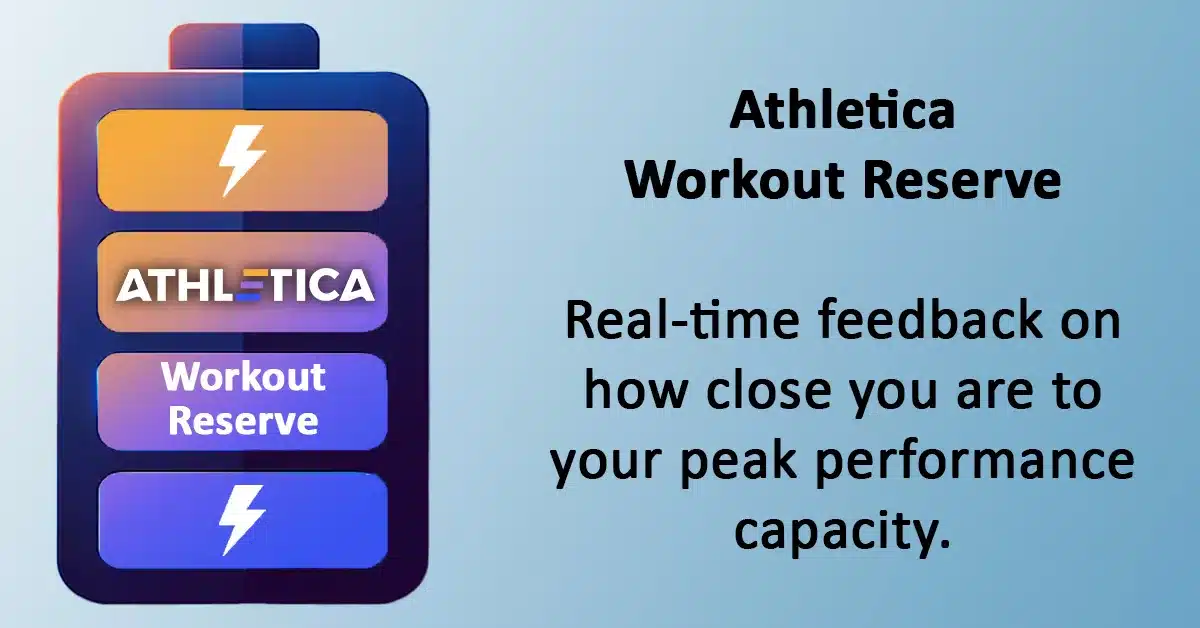One of the many advantages of Athletica is that it transforms your training and race activities into insightful data. Each new upload initiates the calculation of something called ‘rolling averages’; focussing on power output for cyclists and speed for runners. By synthesizing your recent history, Athletica constructs a power/speed profile, highlighting your peak performances across the spectrum of exercise durations measured.
Consider the example of an athlete (ultradistance masters cyclist; Figure 1) whose power profile was crafted from the 25 activities he completed over the past 6 weeks — a clear reflection of his current short and long duration performance potential. That type of history sits within all of us.

Figure 1. An athlete’s power profile derived from 25 training activities over the past 6 weeks.
When you perform any training or race session in Athletica, you are shown your minimum Workout Reserve, which is the smallest margin between your current rolling average and its corresponding historical maximum. To view this in Athletica, go to any bike or run session analysis, and click on the tab “Analysis”. Your Workout Reserve is shown in green as a percentage starting from 100% on the secondary Y-axis (Figure 2).
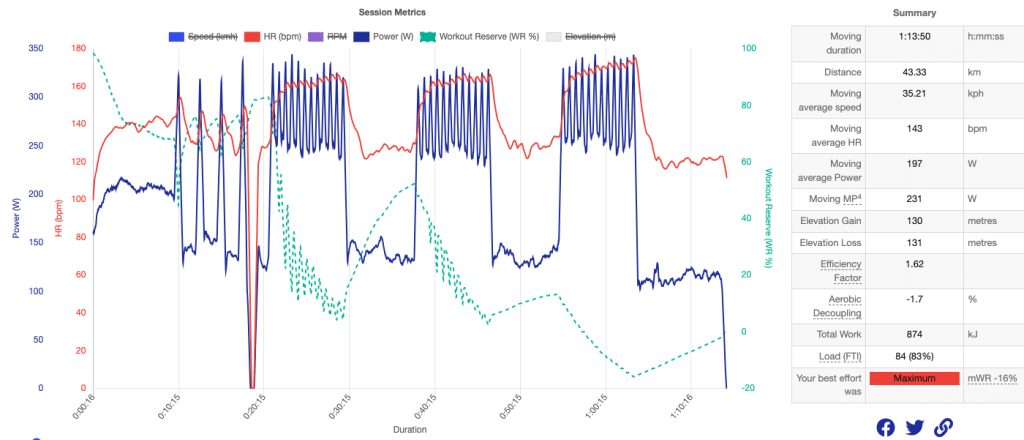
Figure 2. Arbitrary example of the Workout Reserve displayed (green) in every bike and run session analysis chart on Athletica.
Introducing the Game-Changer: Athletica’s Real-Time Workout Reserve on Garmin
Here’s the innovation. Here’s what we believe can help improve your training processes and event performance. Today, you can now have your Workout Reserve displayed in real-time on your Garmin device. During any bike or run activity, Athletica’s Workout Reserve can be prominently displayed in your cockpit on your Garmin device via our Garmin Connect IQ app release, where rolling averages are being calculated and compared to historical maximums (i.e., data Figure 1) in real time!

Athletica’s Workout Reserve displayed in real time onboard the user’s Garmin device.
The minimum Workout Reserve is not just a number; it can also be presented with a duration marker — classified from shorter (“S”, indicating faster) to longer (“L”, indicating slower). This classification is not binary, but one that shifts from short to long in a graduated way, giving you insight into the pace at which the minimum Workout Reserve is evolving (S⇔L), essentially pinpointing the time related rolling averages you are currently achieving relative to your recent past.
Example Athletica Workout Reserve (WR) with advanced short (S) and long (L) duration displayed.
What sets the Athletica Workout Reserve Garmin App apart is its seamless integration with your Athletica power/speed profile (Figure 1), enhancing your Garmin experience. For optimal results, it’s crucial to accumulate 6 weeks of training and racing data. This duration ensures that your Athletica power/speed profile is comprehensively built, incorporating maximal efforts across varying time frames.
Sounds fancy: Explain it to me in cyclist talk; how I can race or train with live Workout Reserve?
Absolutely, it’s all about practicality and making it useful in those crucial moments, whether for you or your team. It’s often said that cycling is like chess on wheels. The strategy is key, and sometimes, outsmarting your competitors is what gets you the win, even if they might be fitter. That’s where the real innovation of Athletica Workout Reserve comes in. It gives you real-time insight into how much you’ve pushed yourself compared to your past performances. It’s like asking yourself, ‘Do I make my move now or should I wait?

When I was a cyclist, we called this concept ‘burning matches’. You’ve got a limited number to burn, and you’ve got to be sure before lighting one up, or else your race could be over just like that. With Athletica Workout Reserve live display on your Garmin, it’s like having a clear view of your matchbox. You know exactly how many you’ve got left compared to your previous efforts of the past (races or training). That kind of knowledge? It’s gold for making smarter decisions on the road like never before.
In the realm of ultra-endurance, the ‘burning matches’ analogy takes on an even greater significance. It’s not just about those high-intensity efforts; it’s about the sustained push that could potentially set your entire box of matches ablaze if you go too hard too soon. This is where Athletica’s Workout Reserve becomes crucial. Consider the WR slider – if it’s far to the right, that’s indicative of your power for longish two-hour efforts. But in an ultra event, where you might have another 5, 10, or even 20 hours to go, seeing your WR hovering near zero early on is a red flag. It signals that you’re reaching your maximum too quickly, leaving little for the long haul ahead.
For those going the distance, it’s a delicate balance. You can allow the slider to shift left, indicating a more sustained effort, but it’s important to bring it back to the right side as soon as feasible. The longer the event, the larger the buffer you should maintain. Ultra-endurance is a test of continuous movement, eating, resting, and then pushing forward again. If you’re too depleted, recovery becomes a distant dream, making it harder to tackle the next part of the event (like the marathon run in an Ironman). Managing your effort wisely with the help of tools like Athletica’s Workout Reserve is key to not just surviving but thriving in these gruelling events.

When it comes to training, how can Athletica Workout Reserve help you become fitter?
While the racing examples highlighted are insightful, the true power of Athletica Workout Reserve lies in optimizing your training regimen. Drawing from our foundations in HIIT Science (Chapter 1, page 14), we acknowledge that while training extremely hard or adhering to the ‘no pain, no gain’ approach can lead to a certain level of fitness, it often results in added stress, increased fatigue, and a higher risk of injury or illness. A more effective strategy is to hit your target stress for any given session and then recover. Consistency in training is the most crucial factor in achieving training adaptation and enhancing performance capacity. This makes your next session the most important one.
Using the Workout Reserve during training provides a clear gauge of how deeply you’re tapping into your reserves compared to your past efforts. It alerts you if you’re pushing too hard on a particular day. If the Workout Reserve is nearing 0% across any session (S⇔L), it’s a signal that you’re in unchartered territory. While it could be adaptation and better output, you can also consider easing off to conserve energy for future workouts. This approach not only enhances training effectiveness but also helps in maintaining a healthy balance, preventing overtraining and ensuring continuous progress.

Understanding Workout Reserve: Its Capabilities and Limitations
Workout Reserve is a powerful tool for measuring your current performance against your personal bests. It acts as a real-time indicator of how closely you are approaching or surpassing your historical peak performances. However, it’s crucial to understand what Workout Reserve does and does not signify.
What it is: Workout Reserve quantifies how your current effort compares to your historical maximum for a specific rolling average. It’s a benchmark of your current performance level.
What it is NOT: Workout Reserve is not an indicator of your energy levels, or anything physiologically-related. A 0% Workout Reserve doesn’t imply that you’re “out of gas” or should feel exhausted. It simply means you’ve matched your historical best in that particular metric. Conversely, a negative Workout Reserve indicates that you’ve exceeded your past records, setting a new personal best. This accomplishment leads to an update in your Athletica power/speed profile, reflecting your improved performance.
Utilizing Athletica Workout Reserve in Training and Racing
Understanding the Minimum Workout Reserve:
Guiding the Stress of your Workout: Use the minimum Workout Reserve as a measure of your workout stress and remaining performance capacity. Remember that not every training session demands a maximum effort! Athletica’s recommended workouts will highlight your key sessions, especially during test weeks which are crucial for building an accurate power/speed profile and ensuring accuracy of Workout Reserve calculations.
Training Types and Workout Reserve Management:
Short Easy-Steady Sessions: Best to go by feel and heart rate for these ones (typically labeled Aerobic or Recovery in Athletica). Remember that Workout Reserve should remain relatively high and constant, and mostly in the “L” domain (Figure 3).
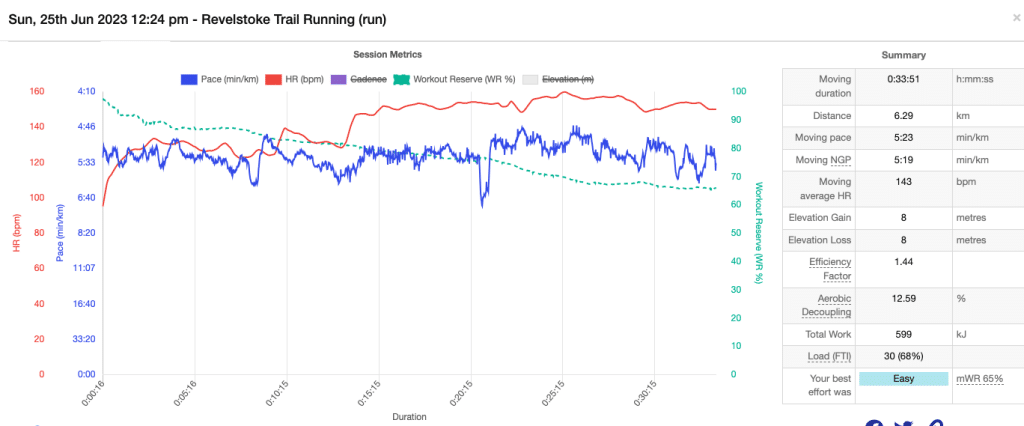
Figure 3. Note how in an easy steady aerobic running session workout reserve remains relatively high and constant.
Long Aerobic Sessions: Aim to control the minimum Workout Reserve, avoiding rapid declines towards 0% early in the session. Focus on maintaining a steady pace for these long duration efforts (“L”) and limit high-intensity bursts (Figure 4).

Figure 4. Example of a longer aerobic steady session with a progressive reduction in workout reserve towards the end.
Strength Endurance Sessions: Aim to gradually deplete your WR, avoiding sharp reductions towards 0% early in the session. Focus on maintaining a steady pace during the moderate intensity pieces while limiting high-intensity efforts (Figure 5).

Figure 5. Example of controlled workout reserve progression during a cycling strength endurance session.
Time-Trials/Tempo Workouts: For these moderate intensity steady effort sessions, target a gradually decreasing minimum Workout Reserve towards 0% with slow variations as you progress towards longer durations (“L”; Figure 6).
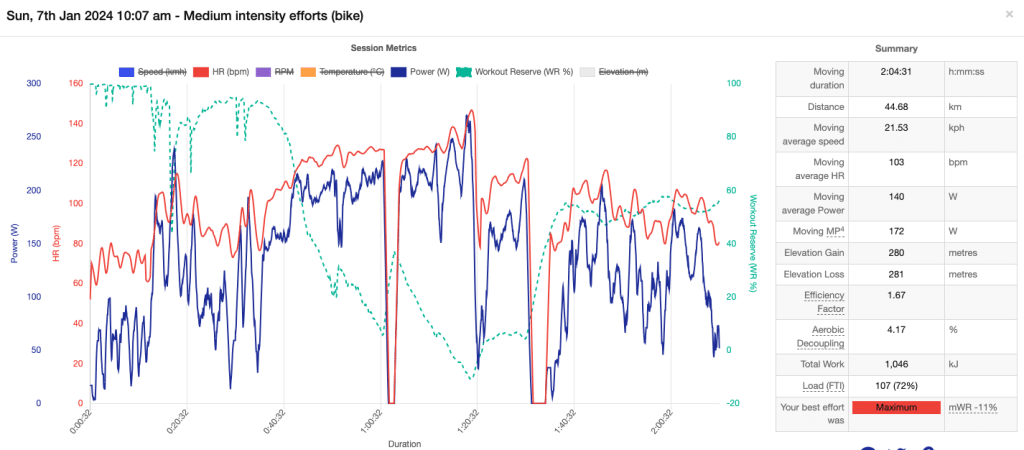
Figure 6. Example of a medium pace mid-zone efforts followed by recovery.
LONG-HIIT Workouts: These sessions challenge both aerobic and anaerobic systems. Expect fluctuating minimum Workout Reserves. Initially, avoid hitting 0% for short durations (“S”). During recovery phases, the Reserve should increase, leaning towards longer “L” durations. As the session progresses, the Reserve will oscillate at lower levels (Figure 7).

Figure 7. Example of a workout reserve profile during long HIIT efforts. Note that in this example effort for the first repetition was not ideal as clearly a match is burnt right off the first effort as evidenced by workout reserve hitting 0.
SHORT-HIIT Workouts: The main target for these sessions is typically your VO2MAX. Initially, manage the minimum Workout Reserve to prevent rapid declines towards short durations (“S”). Gradually, let the Reserve approach 0% for longer durations (“L”) as the session advances. As you can notice from the picture below, the minimum Workout Reserve oscillates much faster in the first part of the session, while towards the end, it fluctuates much slower towards “L” (Figure 8)
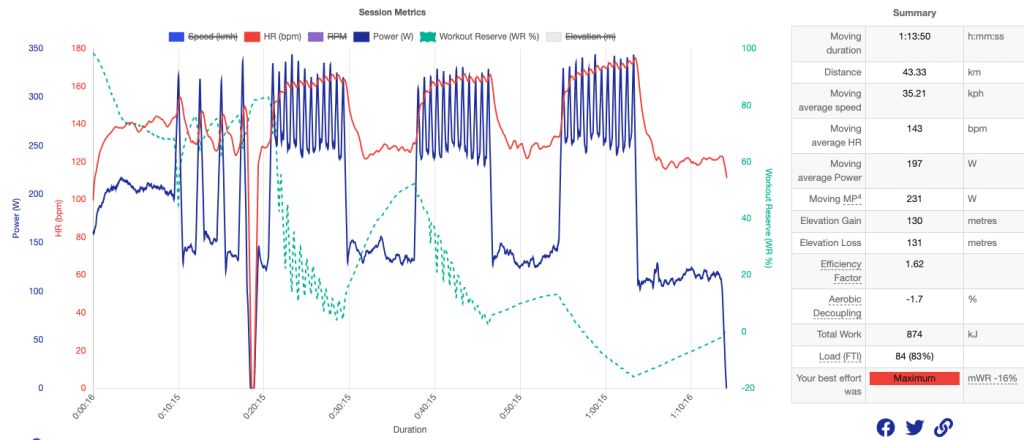
Figure 8. Example of a well paced short-HIIT 30/30 effort alongside a gradually reducing workout reserve.
Application in Racing: The utility of the Athletica Workout Reserve Garmin App varies depending on the race context, especially in self-paced endurance events. If your power/speed profile is well-established, aim for a minimum Workout Reserve of 0% towards the race’s end. A rapid decrease towards 0% for short efforts (“S”) might indicate an nearing end of short intense effort. For races demanding consistent intensity, pace yourself to reach a minimum Workout Reserve of 0% or into negative territory at the finish (Figure 9).
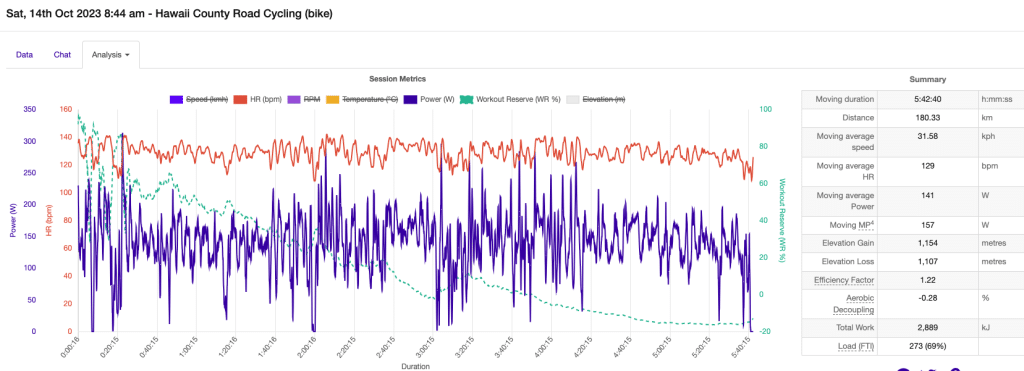
Figure 9. Example of a long race effort (Hawaii Ironman Bike) and a gradually diminishing workout reserve as the race progresses.
Departing Thoughts
At Athletica, our foundation is deeply rooted in scientifically proven principles, a tradition that has long defined our brand’s reputation. As we introduce the Workout Reserve (WR) feature, we uphold our commitment to this scientific ethos. It’s important to note that while the WR concept shows promising potential, it currently stands outside the realm of established scientific evidence. We believe in pioneering innovation and exploring new frontiers in athletic performance. The WR represents our venture into uncharted territory, guided by intuition and a forward-thinking mindset. We offer the WR as a complementary tool, one that we feel could be valuable, yet we encourage our users to engage with it while at the same time understanding its exploratory nature. In this way, we continue to honor our legacy of scientific rigor while embracing the possibilities that innovation brings to the dynamic world of athletic training and performance.
Ready to install Athletica’s Workout Reserve field on your Garmin device for real-time feedback? Click here to take you to the Garmin IQ store and check out this video below to walk you through!
FAQs
How does the Athletica Workout Reserve app handle fluctuations in power or speed due to changes in terrain or environmental conditions? The Workout Reserve number is an indication of your effort relative to prior efforts, so as power, speed or terrain change, WR captures and reflects those changes in effort.
Can the Athletica Workout Reserve be used in conjunction with other metrics, such as heart rate or cadence? Absolutely, WR is not meant to be the one data point to rule them all, but another indicator of overall effort and fatigue over time and should be used in conjunction with other metrics like power and heart rate.
How does the Athletica Workout Reserve app impact the battery life of a Garmin device during long training sessions or races? Computation is done on the device and not by communicating to your phone via Garmin Connect, so the incremental battery usage should be minimal.

